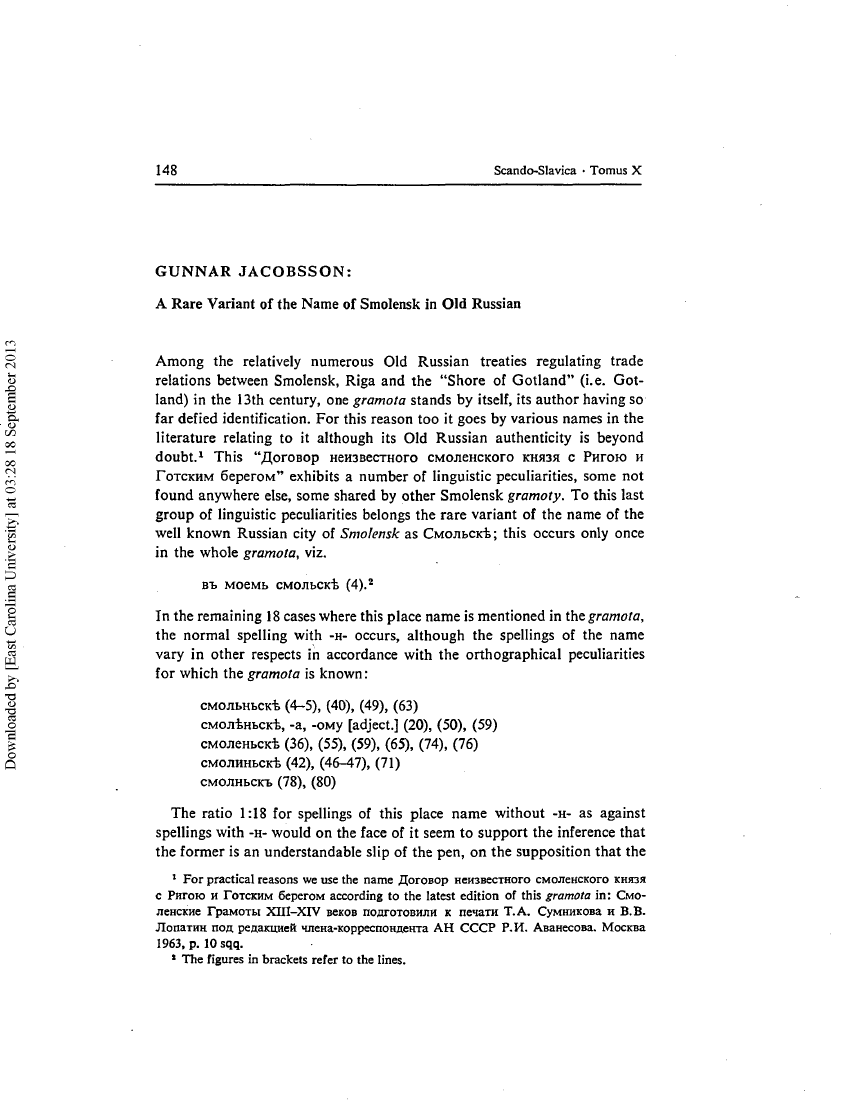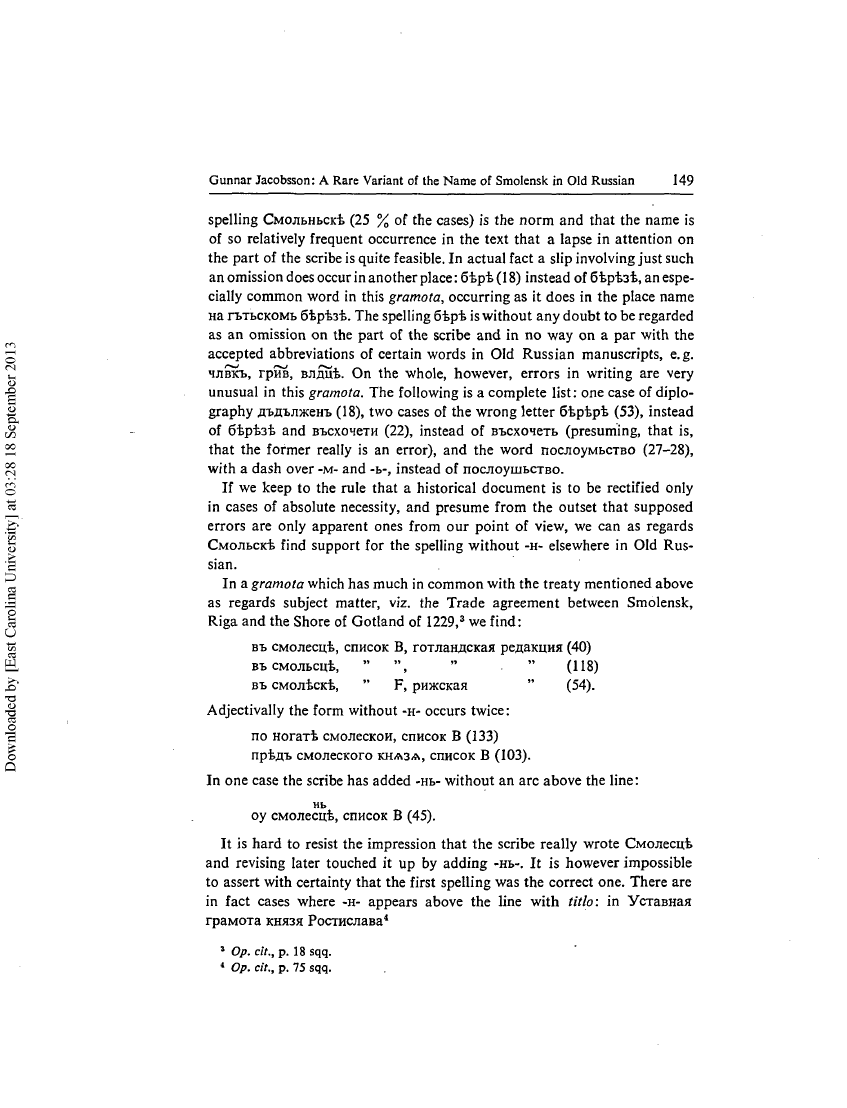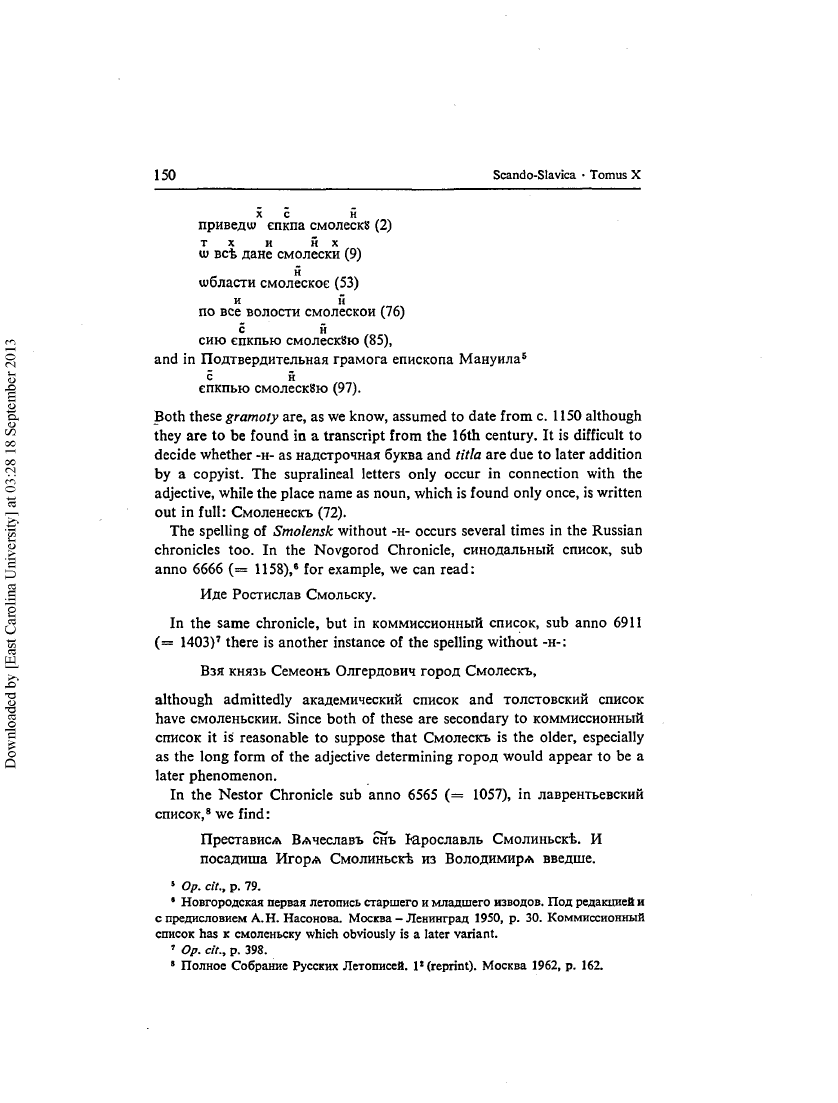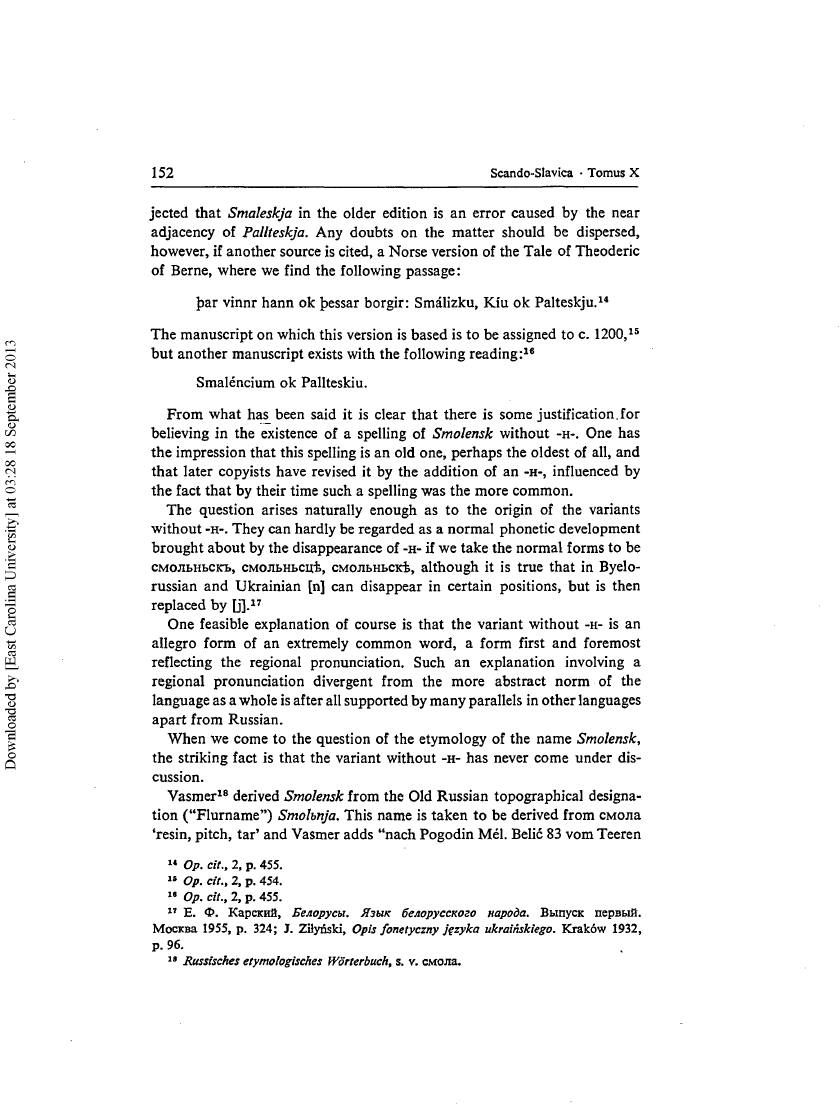
D
o
w
n
lo
ad
ed
by
[E
as
t
C
ar
o
li
n
a
U
n
iv
ers
it
y]
at
03
:2
8
18
S
ep
te
m
b
er
20
13
148
Scando-Slavica · Tomus X
G U N N A R J A C O B S S O N :
A R are Variant of the Name of Smolensk in O ld Russian
A m ong the relatively numerous Old Russian treaties regulating trade
relations between Smolensk, Riga and the “Shore of G o tlan d ” (i.e. G o t
land) in the 13th century, one gramota stands by itself, its au th o r having so
far defied identification. F or this reason too it goes by various names in the
literature relating to it although its Old R ussian authenticity is beyond
do u b t.1 This “Д оговор неизвестного смоленского князя с Ригою и
Готским берегом” exhibits a num ber of linguistic peculiarities, some not
found anywhere else, some shared by other Sm olensk gramoty. To this last
group of linguistic peculiarities belongs the rare variant of the name of the
well known Russian city of Smolensk as С м о л ь с к і; this occurs only once
in the whole gramota, viz.
въ м оем ь см ольск і (4).2
In the remaining 18 cases where this place nam e is m entioned in the gramota,
the norm al spelling with
-
h
-
occurs, although the spellings of the name
vary in other respects in accordance with the orthographical peculiarities
for which the gramota is known:
смольньскЪ (4-5), (40), (49), (63)
см о л ін ь с к і, -а, -ому [adject.] (20), (50), (59)
см оленьскі (36), (55), (59), (65), (74), (76)
см оли н ьскі (42), (46-47), (71)
смолньскъ (78), (80)
The ratio 1:18 for spellings of this place nam e w ithout
-
h
-
as against
spellings with
-H -
would on the face of it seem to support the inference that
the form er is an understandable slip of the pen, on the supposition th a t the
1 F or practical reasons we use the name Договор неизвестного смоленского князя
с Ригою и Готским берегом according to the latest edition of this gramota in: Смо
ленские Грамоты XIII-XIV веков подготовили к печати Т. А. Сумникова и В. В.
Лопатин под редакцией чпена-корреспондента АН СССР Р. И. Аванесова. Москва
1963, р. 10 sqq.
·
1 The figures in brackets refer to the lines.

D
o
w
n
lo
ad
ed
by
[E
as
t
C
ar
o
li
n
a
U
n
iv
ersi
ty
]
at
03
:2
8
18
S
ep
te
m
b
er
2
01
3
G unnar Jacobsson: A Rare Variant of the Name of Smolensk in Old Russian
149
spelling С м ольньскі (25 % of the cases) is the norm and th at the name is
of so relatively frequent occurrence in the text th at a lapse in attention on
the part of the scribe is quite feasible. In actual fact a slip involving just such
an omission does occur in another place: б і р і (18) instead of 6 t p t 3 i , an espe
cially common word in this
gramota,
occurring as it does in the place name
на гътьскомь б і р і з і . The spelling б і р і is w ithout any doubt to be regarded
as an omission on the part of the scribe and in no way on a par with the
accepted abbreviations of certain words in Old R ussian manuscripts, e.g.
члвкь, грив, вл дц і. On the whole, however, errors in writing are very
unusual in this
gramota.
The following is a complete list: one case of diplo-
graphy дьдълженъ (18), two cases of the w rong letter 6 t p t p t (53), instead
of б і р і з і and въсхочети (22), instead of въсхочеть (presuming, that is,
th at the former really is an error), and the word послоумьство (27-28),
with a dash over
-
m
-
and
- ь - ,
instead of послоушьство.
If we keep to the rule th at a historical docum ent is to be rectified only
in cases of absolute necessity, and presume from the outset th at supposed
errors are only apparent ones from o ur point of view, we can as regards
С м о л ьск і find support for the spelling w ithout
-
h
-
elsewhere in Old Rus
sian.
.
In a
gram ota
which has much in com m on with the treaty m entioned above
as regards subject matter, viz. the Trade agreem ent between Smolensk,
Riga and the Shore of G otland of 1229,3 we find:
въ см олесці, список В, готландская редакция (40)
въ см ольсці,
”
” ,
”
.
”
(118)
въ с м о л іс к і,
”
F, рижская
”
(54).
Adjectivally the form without
-
h
-
occurs twice:
по н о г а т і смолескои, список В (133)
прЪдъ смолеского
K H A 3 A ,
список В (103).
In one case the scribe has added -нь- w ithout an arc above the line:
Hb
oy см олесці, список В (45).
It is hard to resist the impression th at the scribe really wrote СмолесцЪ
and revising later touched it up by adding -нь-. It is however impossible
to assert with certainty that the first spelling was the correct one. There are
in fact cases where
-
h
-
appears above the line with
titlo:
in У ставная
грам ота князя Ростислава4
5 Op.
cit.,
p. 18 sqq.
’
4 Op.
cit.,
p. 75 sqq.
.

D
o
w
n
lo
ad
ed
by
[E
as
t
C
ar
o
li
n
a
U
n
iv
ers
it
y
]
at
03
:2
8
18
S
ep
te
m
b
er
2
01
3
150
Scando-Slavica ■ Tomus X
приведи) епкпа смолескЗ (2)
ш всЪ дане смолески (9)
н
шбласти смолеское
(53)
по все волости смолескои (76)
сию епкпью смолеск8ю
(85),
and in Подтвердительная грамога епископа М ануила5
епкпью смолеск8ю (97).
Both these gramoty are, as we know, assumed to date from с. 1150 although
they are to be found in a transcript from the 16th century. It is difficult to
decide w hether
-
h
-
as надстрочная буква and titla are due to later addition
by a copyist. The supralineal letters only occur in connection with the
adjective, while the place name as noun, which is found only once, is written
out in full: Смоленесюь (72).
The spelling of Smolensk without
-
h
-
occurs several times in the Russian
chronicles too. In the N ovgorod Chronicle, синодальный список, sub
anno 6666 ( = 1158),® for example, we can re a d :
И де Ростислав Смольску.
In the same chronicle, but in коммиссионный список, sub anno 6911
( = 1403)7 there is another instance of the spelling w ithout
-
h
- :
Взя князь Семеонъ Олгердович город Смолескь,
although admittedly академический список and толстовский список
have смоленьскии. Since both of these are secondary to коммиссионный
список it is reasonable to suppose th a t Смолескь is the older, especially
as the long form of the adjective determ ining город would appear to be a
later phenom enon.
In the N estor Chronicle sub anno 6565 ( = 1057), in лаврентьевский
список,8 we find:
ПрестависА Вдчеславъ снъ Ьарославль СмолиньскЬ. И
посадиша ИгорА СмолиньскЬ из ВолодимирА введше.
5 Op. cit., р. 79.
• Новгородская первая летопись старшего и младшего изводов. Под редакцией и
с предисловием А. Н. Насонова. Москва - Ленинград 1950, р. 30. Коммиссионный
список has к смоленьску which obviously is a later variant.
7 Op. cit., p. 398.
* Полное Собрание Русских Летописей. 1* (reprint). Москва 1962, p. 162.

D
o
w
n
lo
ad
ed
by
[E
as
t
C
ar
o
li
n
a
U
n
iv
ers
it
y]
at
03
:2
8
18
S
ep
te
m
b
er
20
13
Gunnar Jacobsson: A Rare Variant of the Name of Smolensk in Old Russian
151
In all the other m anuscripts the place name is spelt with
а п -
h
-
except for
и п а т ь е в с к и й с п и с о к ,
the text of which is somewhat divergent here:9
Престависл ВАчеславъ снъ ЬЗрославль Смоленским,
и посадиша И горд вь СмольсцЪ изъ В олодимерл выведше.
Now the interesting fact is th at an
-
h
-
with an arc has been added above
смольсц'Ъ in different ink. One is really justified in wondering whether
the spelling without
-
h
-
is not the original one, which has later been revised
supralineally by a later copyist. Supralineal
-
h
-
occurs also in the spelling
H
смолескоу which appears in хлебниковский список and погодинский
список10, both considered as later than ипатьевский список: W hat is so
confusing is that the adjective смоленьскии is to be found in the same
passage, for in this case there is no doubt as to the existence of an
-
h
-.
By and large, however, the spellings of Smolensk and the adjective derived
from it which have
-
h
-
are numerically in such an overwhelming m ajority
that the cases without
-
h
-
m ust be regarded as unique in Old Russian.
However, there turn out to be instances of the spelling w ithout
-
h
-
from
quite different sources, viz. Old Norse. The instances are not perhaps
striking at first glance, for b oth spellings occur. In a geographical account
of ancient Rus' by the abb o t Nicolas from Thingeyrar in Iceland, we read:
i austanverôri Eyropa er G arôariki; Jjar er Kæ nugarôr
ok Holm garôr, Pallteskja ok Smalenskja.
The extract originates from Antiquités Russes.11 It is of interest, however,
that there exist two editions of the chapter in which the city of Smolensk
is mentioned, one older and one newer. The older edition can be said to date
from the middle of the 12th century,12 while the newer one presum ably dates
from the end of the 13th century or the beginning of the 14th.13 N ow in the
older edition the spelling is Smaleskja, and it is solely the fact of its being
the more usual one th at accounts for thé editor of Antiquités Russes in
serting the spelling of the newer edition with -n-. It could perhaps be ob
* Op. cit., 2, p. 151.
10 Ibidem.
11 Antiquités Russes d'après les monuments historiques islandais et des anciens Scandi
naves, éditées par la Société Royale des Antiquitaires du Nord. 1-2. Copenhague 1850
1852, 2, p. 403.
12 “Plusieurs indices nous en conduisent à en rapporter l’auteur au milieu du 12e
siècle”, op. cit., 2, p. 395.
.
13 Ibidem.

152
Scando-SIavica · Tomus X
jected th a t Smaleskja in the older edition is an erro r caused by the near
adjacency of Pallteskja. Any doubts on the m atter should be dispersed,
however, if another source is cited, a N orse version of the Tale of Theoderic
of Berne, where we find the following passage :
Трат vinnr hann ok gessar borgir: Smälizku, K iu ok Palteskju.14
T he m anuscript on which this version is based is to be assigned to c. 1200,15
bu t another m anuscript exists with the following reading:16
Smaléncium ok Pallteskiu.
F rom w hat has been said it is clear th a t there is some justification.for
believing in the existence of a spelling of Sm olensk w ithout
- h - .
One has
the impression th at this spelling is an old one, perhaps the oldest of all, and
th a t later copyists have revised it by the addition of an
-
h
- ,
influenced by
the fact th a t by their time such a spelling was the m ore common.
The question arises naturally enough as to the origin of the variants
w ithout
-H -.
They can hardly be regarded as a norm al phonetic development
b rought about by the disappearance of
-
h
-
if we take the norm al form s to be
смольньскъ, смольньсцЪ, смольньскЪ, although it is true th at in Byelo
russian and U krainian [n] can disappear in certain positions, bu t is then
replaced by [j].17
One feasible explanation of course is th a t the variant w ithout
-
h
-
is an
allegro form of an extremely com m on w ord, a form first an d forem ost
reflecting the regional pronunciation. Such an explanation involving a
regional pronunciation divergent from the m ore abstract norm of the
language as a whole is after all supported by m any parallels in other languages
ap a rt from Russian.
W hen we come to the question of the etymology of the nam e Smolensk,
the striking fact is th a t the variant without
-
h
-
has never come under dis
cussion.
V asm er18 derived Smolensk from the Old R ussian topographical designa
tion ( “F lurnam e”) Sm ohnja. This nam e is taken to be derived from см ола
‘resin, pitch, ta r’ and Vasmer adds “nach Pogodin Mèi. Belie 83 vom Teeren
14 Op. cit., 2, p. 455.
15 Op. cit., 2, p. 454.
Ie Op. cit., 2, p. 455.
17 E. Ф. Карский, Белорусы. Язык белорусского народа. Выпуск первый.
Москва 1955, р. 324; J. Zilynski, Opis fonetyczny fezyka ukrainskiego. Kraków 1932,
p. 96.
18 Russisches etymologisches Wörterbuch, s. v. смола.

D
o
w
n
lo
ad
ed
by
[E
as
t
C
ar
o
li
n
a
U
ni
ve
rsi
ty
]
at
03
:2
8
18
S
ep
te
m
b
er
2013
Gunnar Jacobsson: A Rare Variant of the Name of Smolensk in Old Russian
153
der Schiffe”.19 Curiously enough Pogodin is not the first to have put for
ward this view; he in his tu rn quotes V. S. Ikonnikov.20 But not even Ikon
nikov is the original source, for he cites E. Golubinskij.21
This explanation does not sound im probable but it does not take the
variant w ithout
-
h
-
into consideration which in the light of w hat has already
been said we regard as just as worthy of recognition as the one with
-
h
-
in
Old Russian.
There m ust in fact have been one base sm ohn- and one smol-. С м о л ьскі
presupposes the latter. It is from this th at Smolěne in Old Bulgarian is
derived, which is found as early as in the the eighth century in the form ІцоХ-
eávoi.22 We find the same derivative in West Slavonic in the form Smeldingi.23
It is also of interest th at the inhabitants of Smolensk are called in Old
Russian literature both Смольняне (the commonest word) and Смоляне.24
We draw the conclusion therefore th at the Old Russian form СмольсісЬ
has every appearance of being authentic. And everything points to the fact
that it is actually of greater antiquity than the form Смольньскъ.
“ А. Погодин in: Mélanges linguistiques et philologiques offerts à M. Aleksandar
Belie... Beograd 1937, pp. 77-85.
20 В. С. Иконниковъ, Опытъ русской исторіографіи, T. II, Кн. І, Кіевь 1908, р.500.
51 Е. Голубинскій, Исторія русской церкви. 1:1s. Москва 1901, р. 19, note 1 : “...с ъ
Смоленска (гдЪ смолились, - древнее названіе Смоленска Смолинескъ, и окон
чательно приготовлялись л о д к и ...)”.
“
22 L. Niederle, Slovanské starožitnosti. 11:1-2. V Praze 1906, p. 428.
23 R. Trautmann, Die slavischen Ortsnamen Mecklenburgs und Holsteins. Zweite, ver
besserte Auflage. Berlin 1950 ( = Abhandlungen der Sächsischen Akademie der Wissen
schaften zu Leipzig. Philologisch-historische Klasse. Band 45. Heft 3), p. 141 s.v. Smel
dingi; cf. also M. Vasmer, Die Slaven in Griechenland ( = Abhandlungen der Preussischen
Akademie der Wissenschaften. Jahrgang 1941. Philosophisch-historische Klasse. Nr. 12.
Berlin 1941), pp. 75, 97.
21 E. g. in the Novgorod Chronicle, академический список and толстовский список,
sub anno 1169, although коммиссионный список has the spelling with -н-; in the
Vologda-Perm Chronicle (=ITCPJI. 26. Москва 1959), чертковский список, sub anno
И З 7; Дополненія къ Актамъ историческимъ. .. I. С.-Петербургь 1901, р. 164.
Wyszukiwarka
Podobne podstrony:
In the Name of the?ther (Guildford Four and Maguire Seven)
CAST OUT DEMONS IN THE NAME OF JESUS
The Name of the Rose
Calling On The Name Of Avalokiteshvara John Tarrant (Zen, Buddhism, Koan)
The Name and Nature of Translation Studies In James S Holmes
The Name of the Game Willa Okati
The Pronunciation of the Name by Nehemiah Gordon
The Name of the Rose doc
James S Holmes The Name and Nature of Translation Studies
The name of the game
The Name Of The Game
Guide to the properties and uses of detergents in biology and biochemistry
Newell, Shanks On the Role of Recognition in Decision Making
How?n the?stitution of Soul in Modern Times? Overcome
The History of the USA 6 Importand Document in the Hisory of the USA (unit 8)
Political Thought of the Age of Enlightenment in France Voltaire, Diderot, Rousseau and Montesquieu
Existence of the detonation cellular structure in two phase hybrid mixtures
więcej podobnych podstron